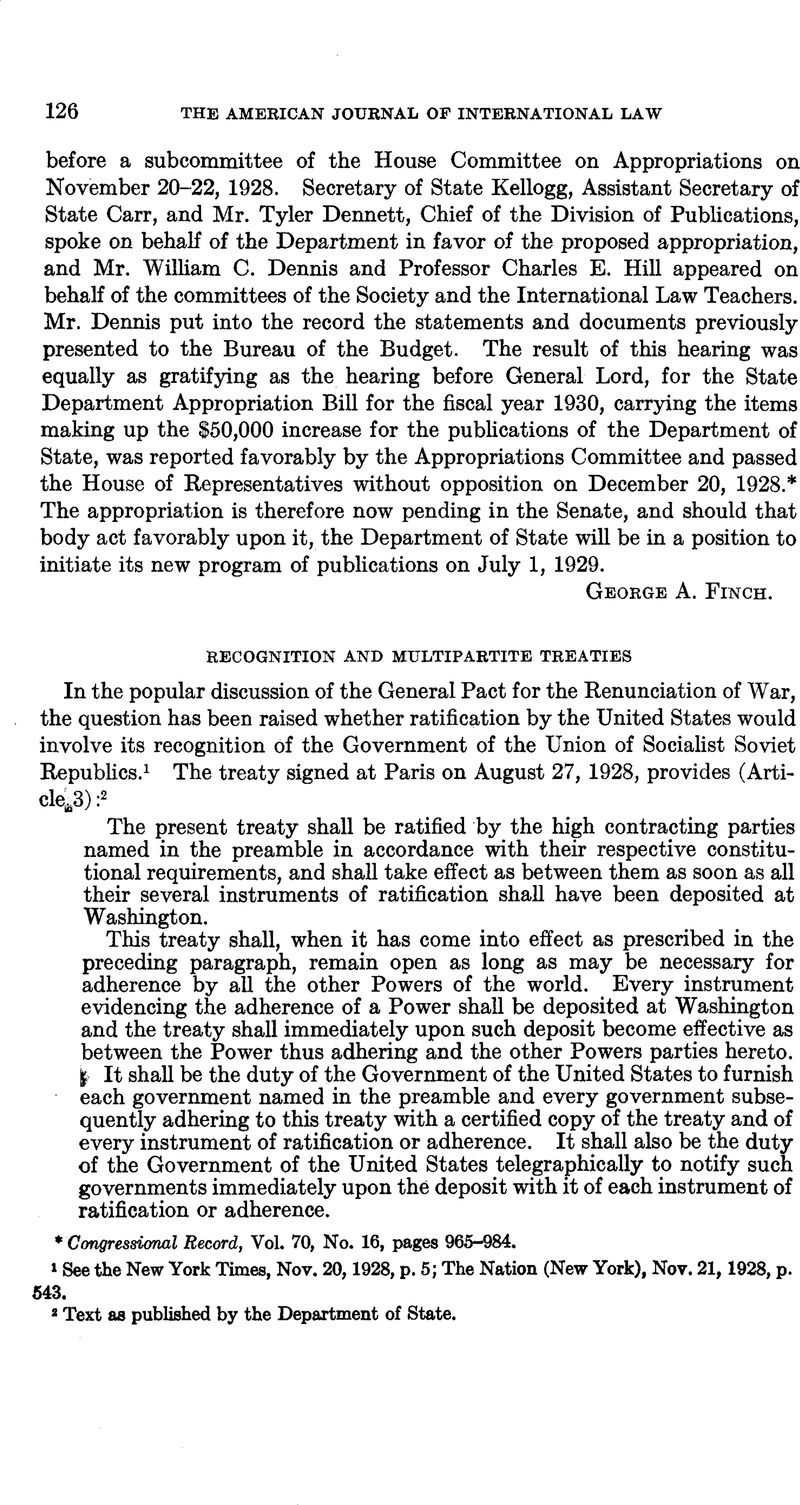Article contents
Recognition and multipartite treaties
Published online by Cambridge University Press: 06 June 2017
Abstract

- Type
- Editorial Comment
- Information
- Copyright
- Copyright © American Society of International Law 1929
References
1 See the New York Times, Nov. 20,1928, p. 5; The Nation (New York), Nov. 21,1928, p.543.
2 Text as published by the Department of State.
3 See press releases of the Department of State, of Oct. 4, 1928.
4 “ Juridically, a government that is unrecognized may be viewed as no government at all, if the power withholding recognition chooses thus to view it. In practice, however, since juridical conceptions are seldom, if ever, carried to the limit of their logic, the equivalence is not absolute, but is subject to self-imposed limitations of common sense and fairness, as we learned in litigations following our Civil War.” Cardozo, J., in Sokoloff v. National City Bank (1924), 239 N. Y. 158.
5 This statement is attributed to Secretary Kellogg. New York Times,Sept. 28, 1928, p. 10.
6 In the Annette, [1919] Probate, 105, it was thought that Great Britain had not recognized the Provisional Government of Northern Russia, though that government had a representative in London and a British commissioner had been sent to Archangel. The United States maintained a chargi, d'affaires at Mexico during a period in which no government of Mexico was recognized. See, especially, United States on behalf of George W. Hopkins v. United Mexican States, Opinions of the Commissioners, Claims Commission of the United States and Mexico, p. 42.
7 See, however, Maurice Fontaine, “ Have We Recognized Soviet Russia?” , The Nation (Nov. 21, 1928), p. 543.
8 In 1 Oppenheim, International Law (4th ed., 1928), p. 145 note. Se also 1 Hyde, International Law, § 37; Hershey, Essentials of International Public Law and Organization, p. 200.
9 This was reported to be the view held in the Department of State. New York Times, Sept. 28, 1928, p. 10. For the text of the Treaty with China, see the Department of State press release of July 27, 1928, and supplement to this J o u r n a l , Oct. 1928 (Vol. 22), p. 170.
10 See Manley O. Hudson, “ Membership in the League of Nations,” this Journal , Vol. 18, pp. 436, 439
11 U. S. on behalf of Hopkins v. United Mexican States, cited ante, note 6.
12 See League of Nations Document, C. L. 136. 1926 VIII Annex
13 In the discussions of the reorganization of the Pan American Union at the Fifth International Conference of American States at Santiago, special attention was given to the participation in the maintenance of the Pan American Union of states which “might have severed diplomatic relations with any other country of the American Continent.” See Acts of the Conference, p. 485. See also Report of the Delegates of the United States of America to the Fifth International Conference of American States, p. 5.
14 See Senate Document, No. 744, 61st Cong., 3rd Sess.
15 See also the Foreign Policy Association Information Service, Vol. 4, No. 18 (Nov. 9, 1928), p. 374, concerning the signature of the Lausanne Convention of July 24,1923, relating to freedom of transit and navigation of the Straits.
16 44 U. S. Statutes, p. 2221. In Russian Re-Insurance Co. v. Stoddard, (1925) 211 App. Div. 132, (1925) 240 N. Y. 149, one of the findings of the trial court was that “ the United States has concluded no treaties with Russia as represented by the Russian Socialist Federated Soviet Republic.” The judgment of the trial court had been entered on Oct. 9, 1924, several weeks after the signing of the convention at Stockholm.
17 44 U. S. Statutes, p. 2348.
18 Altman & Co. v. U. S., (1912) 224 U. S. 583.
19 69 Congressional Record (March 22, 1928), p. 5380.
20 See U. S. Treaty Series, No. 762. The ratification was deposited at Paris on May 22, 1928.
21 Reference may also be made to the treaty concerning the Archipelago of Spitzbergen, of February 9,1920, which provides for adherence by “ third powers.” See 2 League of Nations Treaty Series, p. 7. This treaty was ratified by the United States, and the ratification was deposited at Paris on April 2, 1924. See 39 Id., p. 165; and Supplement to this Journal, Vol. 18 (1924), p. 199.
22 Since the treaty will not come into force until the ratifications of all the signatories are deposited at Washington, the provision for adherence by non-signatory states is not effective prior to that time, and hence no instrument of adherence can be affective as such, under the provision, until after the treaty comes into force. Yet the declaration signed by M. Iitvinoff on September 6, 1928, is in form definitive, and nothing remains to be done by the Union of Soviet Socialist Republics. It might have been a possible construction that the treaty was open to adherence only by those Powers which all the signatories shall have recognized as such; but this possibility has been foreclosed by events.
23 See David Hunter Miller, The Peace Pact of Paris, c. 18; James T. Shotwell, War as an Instrument of Policy, c. 20.
- 3
- Cited by




